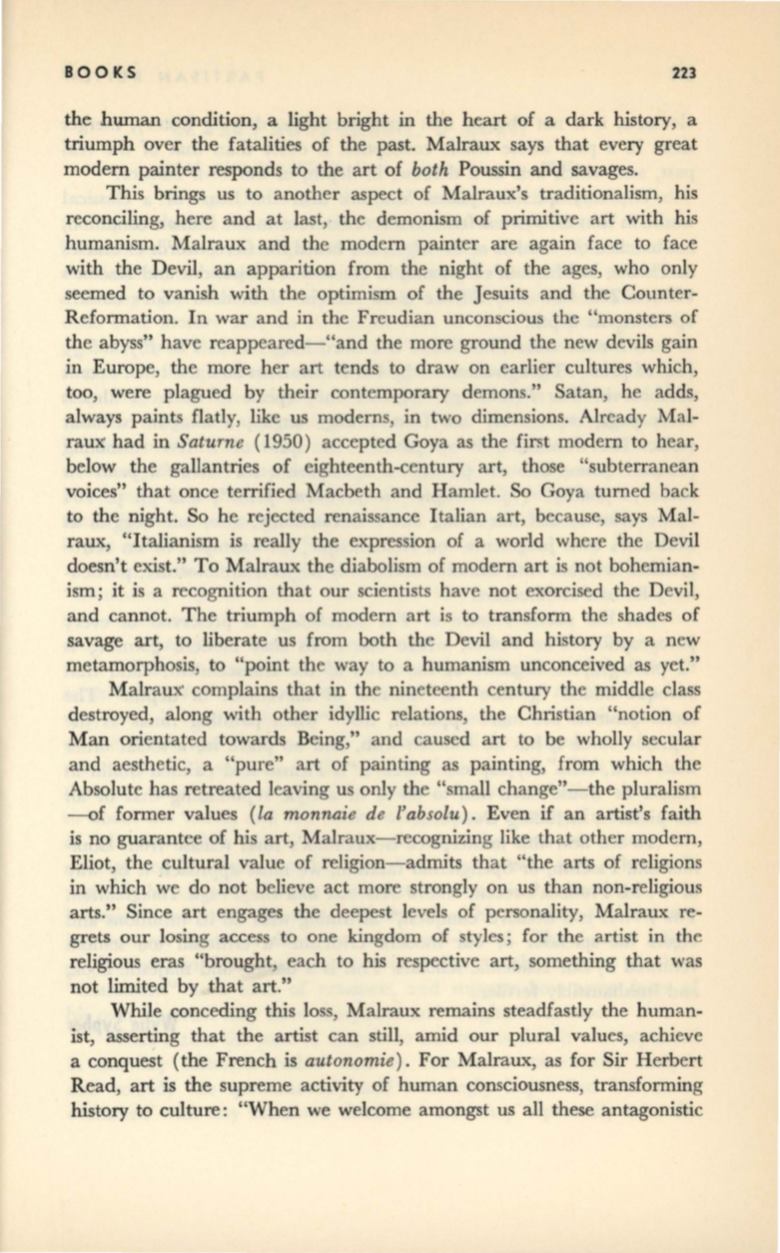
BOOKS
223
the human condition, a light bright
in
the heart of a dark history, a
triumph over the fatalities of the past. Malraux says that every great
modern painter responds to the art of
both
Poussin and savages.
This brings us to another aspect of Malraux's traditionalism, his
reconciling, here and at last, the demonism of primitive art with his
humanism. Malraux and the modern painter are again face to face
with the Devil, an apparition from the night of the ages, who only
seemed to vanish with the optimism of the Jesuits and the Counter–
Reformation. In war and in the Freudian unconscious the "monsters of
the abyss" have reappeared- "and the more ground the new devils gain
in Europe, the more her art tends to draw on earlier cultures which,
too, were plagued by their contemporary demons." Satan, he adds,
always paints flatly, like us moderns, in two dimensions. Already Mal–
raux had in
Saturne
(1950) accepted Goya as the first modern to hear,
below the gallantries of eighteenth-century art, those "subterranean
voices" that once terrified Macbeth and Hamlet. So Goya turned back
to the night. So he rejected renaissance Italian art, because, says Mal–
raux, "Italianism is really the expression of a world where the Devil
doesn't exist." To Malraux the diabolism of modern art is not bohemian–
ism; it is a recognition that our scientists have not exorcised the Devil,
and cannot. The triumph of modern art is to transform the shades of
savage art, to liberate us from both the Devil and history by a new
metamorphosis, to "point the way to a humanism unconceived as yet."
Malraux' complains that in the nineteenth century the middle class
destroyed, along with other idyllic relations, the Christian "notion of
Man orientated towards Being," and caused art to be wholly secular
and aesthetic, a "pure" art of painting as painting, from which the
Absolute has retreated leaving us only the "small change"- the pluralism
-of former values
(la monnaie de l'absolu).
Even
if
an artist's faith
is no guarantee of his art, Malraux- recognizing like that other modern,
Eliot, the cultural value of religion- admits that "the arts of religions
in
which we do not believe act more strongly on us than non-religious
arts." Since art engages the deepest levels of personality, Malraux re–
grets our losing access to one kingdom of styles; for the artist in the
religious eras "brought, each to his respective art, something that was
not limited by that art."
While conceding this loss, Malraux remains steadfastly the human–
ist, asserting that the artist can still, amid our plural values, achieve
a conquest (the French is
autonomie ).
For Malraux, as for Sir Herbert
Read, art is the supreme activity of human consciousness, transforming
history to culture: "When we welcome amongst us all these antagonistic


